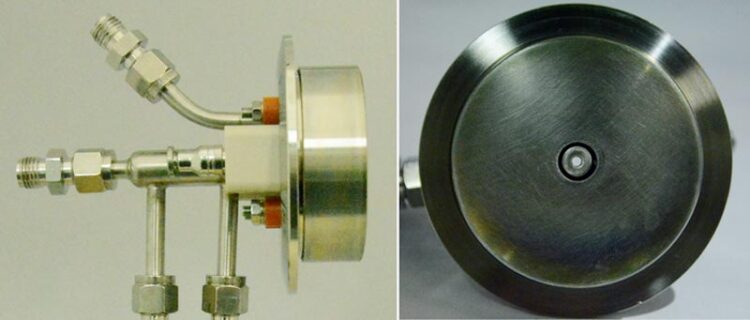Ultra-high-rate plasma coating to improve surface function

Coaxial gas injection plasma jet source with a circular nozzle for Ar plasma jet injection with a central C2H2 injection nozzle at its center (Left) side view, (right) front view.
Credit: (c) Toyohashi University of Technology
Reduces friction and extends product life.
Toyohashi University of Technology research team led by lecturer Toru Harigai have developed an ultra-high-rate coating technology for functional hard carbon films using vacuum plasma. Functional hard carbon films with low friction coefficients are used as protective films with sliding surfaces. This technology has achieved a film deposition rate of more than one order of magnitude faster than existing coating technologies, while maintaining the same degree of film quality. The technology—which can be introduced using a unique gas injection method and simple equipment configuration—can be expected to be applied in improving the functional performance of general-purpose products and other mass-produced products.
Details
Diamond-like carbon (DLC) is a hard carbon film material with various functions such as high biocompatibility and oxygen impermeability. It is widely used in sliding parts of tools and automobiles, especially as a functional protective coating material that protects the surface of the base material while at the same time imparting sliding properties (slipperiness) to the base material due to its low friction coefficient. This hard carbon film can only be synthesized by vacuum plasma technology. Since the deposition rate for existing technologies is a few 100 nm/min, there are few advantages in terms of cost effectiveness to apply to mass-produced products, and they have mainly been applied to high added-value products. Additionally, since there is essentially a trade-off between the hardness of the film and the deposition rate, the development of technologies that improve deposition rate while maintaining the hardness (quality) of films is desirable from an applied engineering standpoint.
The research team proposed a unique gas injection method in which two kinds of gas were ejected in a jet shape and mixed in a vacuum, and achieved ultra-high-rate film formation for hard carbon films exceeding the deposition rate for existing techniques by more than one order of magnitude, with a plasma deposition device utilizing this gas injection method. By achieving ultra-high-rate film formation through this gas injection method, the team has removed the need to form a complex discharge electrode in or around the object being coated, so it can be expected to be used as a highly versatile process that can be applied to a diverse range of materials and shapes.
Development Background
In the initial stages of the research, problems such as carbon film adhesion in unintended places and clogging of the gas exhaust system due to large amounts of dust occurred due to the generation position and expansion of the plasma, and the desired results of hard film formation and improved deposition speed were not obtained. By making multiple improvements to the equipment based on the knowledge obtained through a process of trial and error, ultra-high-rate film formation exceeding a rate of 2 μm/min was eventually achieved through plasma generation utilizing the team’s unique gas injection method. This technology is based on the combination of gases and well-known existing techniques for the formation of plasma, which forms the basis for film formation. In combining these techniques, by creating an environment that is very different locally from the existing methods, the team was able to obtain new results that broke down the trade-off between film hardness and deposition speed, which had been the common wisdom until now.
Future Outlook
The research team plans to expand the size of the high-speed deposition area for practical application of equipment utilizing this technology. They believe that coating of cylindrical inner walls and complex structures will also become possible through further research and development. In the future, they hope to achieve widespread adoption of this new coating technology and contribute to the creation of a society capable of sustainable development, by improving energy consumption by applying the excellent sliding properties of hard carbon films.
Reference
Toru Harigai, Hikaru Ohhra, Ryoya Tominaga, Takahiro Bando, Hirofumi Takikawa, Shinsuke Kunitsugu, and Hidenobu Gonda
“Ultra-high-rate deposition of diamond-like carbon films using Ar/C2H2 plasma jet CVD in combination with substrate-stage discharge”
Japanese Journal of Applied Physics (2022) in press.
10.35848/1347-4065/ac54f8
This research was conducted with the support of the Osawa Scientific Studies Grants Foundation.
Journal: Japanese Journal of Applied Physics
DOI: 10.35848/1347-4065/ac54f8
Method of Research: Experimental study
Subject of Research: Not applicable
Article Title: Ultra-high-rate deposition of diamond-like carbon films using Ar/C2H2 plasma jet CVD in combination with substrate-stage discharge
Article Publication Date: 14-Feb-2022
Media Contact
Yuko Ito
Toyohashi University of Technology (TUT)
service@rac.tut.ac.jp
All latest news from the category: Process Engineering
This special field revolves around processes for modifying material properties (milling, cooling), composition (filtration, distillation) and type (oxidation, hydration).
Valuable information is available on a broad range of technologies including material separation, laser processes, measuring techniques and robot engineering in addition to testing methods and coating and materials analysis processes.
Newest articles

High-energy-density aqueous battery based on halogen multi-electron transfer
Traditional non-aqueous lithium-ion batteries have a high energy density, but their safety is compromised due to the flammable organic electrolytes they utilize. Aqueous batteries use water as the solvent for…

First-ever combined heart pump and pig kidney transplant
…gives new hope to patient with terminal illness. Surgeons at NYU Langone Health performed the first-ever combined mechanical heart pump and gene-edited pig kidney transplant surgery in a 54-year-old woman…

Biophysics: Testing how well biomarkers work
LMU researchers have developed a method to determine how reliably target proteins can be labeled using super-resolution fluorescence microscopy. Modern microscopy techniques make it possible to examine the inner workings…





















